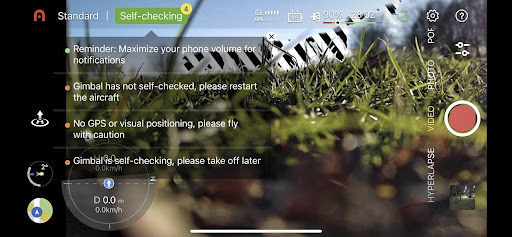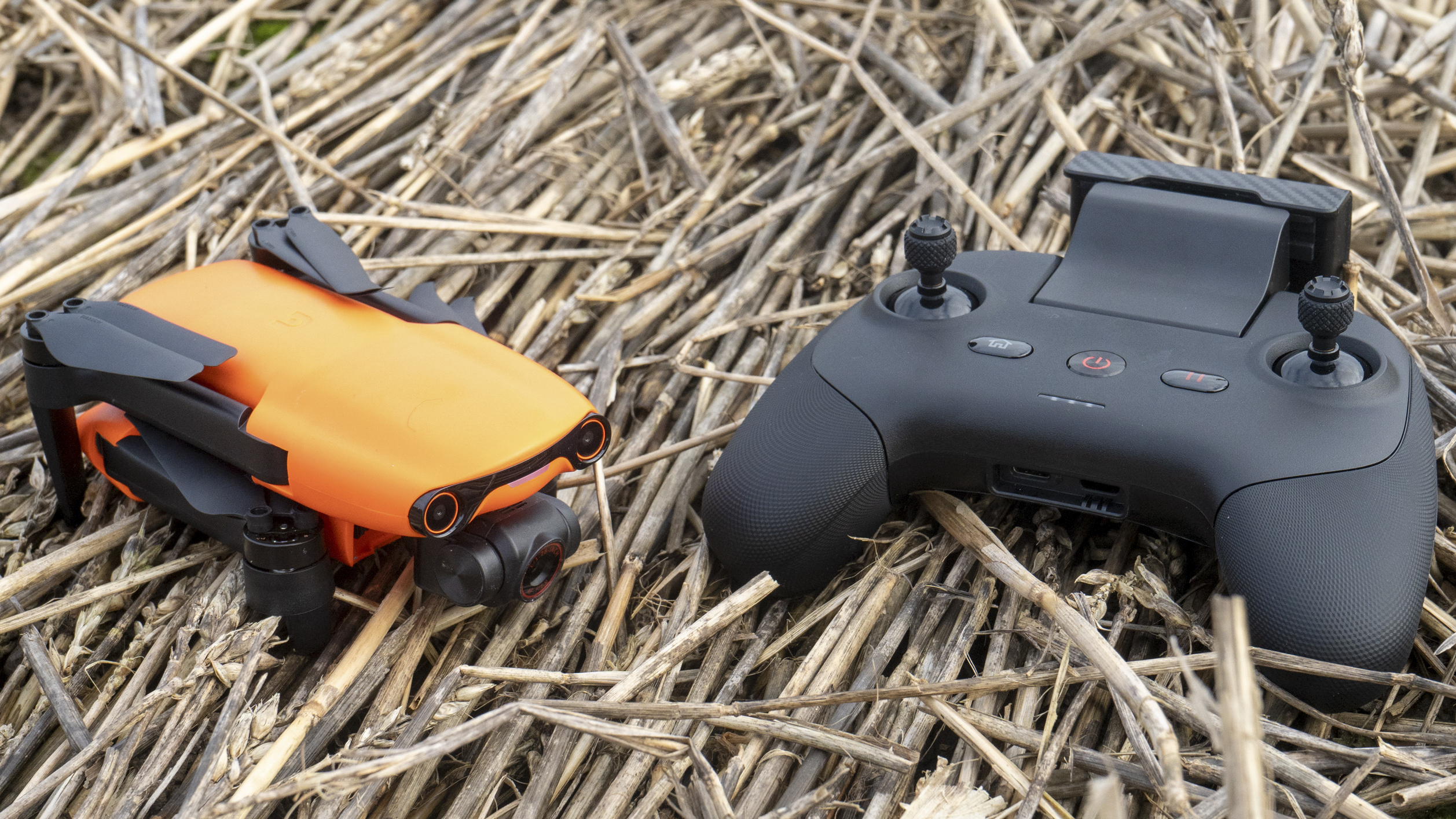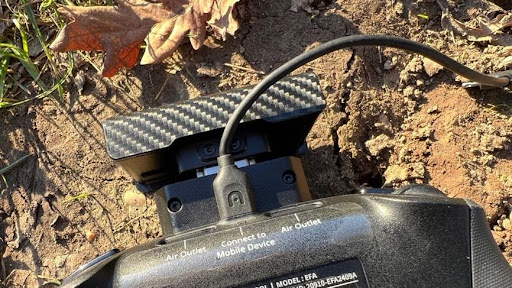Digital Camera World Verdict
The Autel EVO Nano+ represents a striking step up not only for Autel, but for what’s possible in this weight category. Bringing a large sensor and three-way collision sensing, this machine is both safe to operate and brings home excellent images. There are undoubtedly a few niggles, but that list was shortening even during our testing period, which fills us with hope. At the same time aspects like the high-resolution live preview and subject tracking give you professional capabilities with incredible portability.
Pros
- +
4K video
- +
2.7K live preview
- +
Phase-contrast autofocus
Cons
- -
Sensor claims 50-megapixels but captures 12.6-megapixel images
- -
Limited choice of frame rates
- -
Voice alerts don’t seem to add much
Why you can trust Digital Camera World
Testing the Autel EVO Nano+ was exciting. Waiting for the weather to let us, not so much, but that’s life. This machine is so significant because – while we’ve seen others chip at DJI’s undoubted “big boy” status – this is the first time in a while a drone has stepped out and appeared to claim market leader status in its category. Not only that, but the category in question – sub 250g aircraft – is probably the most important one in the world of camera drones right now.
How can that have happened? DJI have been laying claim to this ground for some time now, with the DJI Mini 2 and Mini SE offering 4K and 1080P options depending just how much customers are prepared to part with for the camera. Unlike Autel, however, they’ve not managed to (or chosen to) fit vision sensor pairs (collision sensors) on their lightweight aircraft (base excepted). Nor does the Mini 2’s image sensor have anything like the size, with a pretty pedestrian 1 / 2.3” (7.66mm) compared to the Nano+.
That isn’t to say that the Autel Robotics EVO Nano series is flawless, but they do address a lot of areas which a photographer or creator would prioritize while still managing to fit in tech which is becoming increasingly expected on modern drones. The EVO Nano is sold in two flavors: Nano and Nano+. The former is not yet available as we write, but will be sold with a 48-megapixel half-inch camera, while the Nano+ (which we’re trying) has a 1/1.28-inch RYYB sensor. Both offer 4K at 30fps.
Oh, and if comparing these sensor size measurements makes your brain itch, try the ever more logical metric: the Nano+’s sensor measures 19.8mm diagonally, compared to 12.7mm for the Nano.
The Drone
Knocking DJI’s Mini 2 aside in terms of technical achievement and becoming the best specified drone in the regulator-friendly sub-250g category is no mean achievement, and we can’t say another word about the Evo Nano+ (and the rest of the Nano series) without drawing attention to that straight away.
The Evo Nano is available in four shades. If we were buying for ourselves, we might have picked the ‘Deep Space Gray’ model with the cool yellow accent, but as you can see we’re testing the ‘Autel Orange’ model which is certainly very striking, though it does rather highlight some of the design similarities the Nano shares with the older Autel EVO II (orange body, black legs and a black bar joining the front vision sensors). There is no crime in following a and developing style, though, and it is impressive it has been achieved here at such a low weight.
The camera-and-gimbal unit is protected by a removable plastic cover which could be easier to get on but does a fine job once in place. Behind that a rubber strap is provided to prevent the propellors roaming free and this does a surprisingly good job. Once these are off, the legs can be unfolded and the full Nano revealed.
The best camera deals, reviews, product advice, and unmissable photography news, direct to your inbox!
The base includes an ultrasonic sensor and two vision sensors as well as the vents for a fan which is likely what nudges the flight times slightly below the DJI Mini drones but also handles the compute power needed to handle collision avoidance and other on-board processing. The front and rear also sport a pair of vision sensors meaning the drone can ‘see’ forward, downward and backward – to around 8m (over 25ft) in our testing. Also at front and back are LED status indicators, and the back has a USB-C port which can be used for charging or data transfer, and a microSD card socket (more of which later).
Overall we have no complaints about the construction; it is remarkable that so much can fit into the weight limit set by aviation authorities. Admittedly it’d be nice to have longer legs – the camera isn’t 10mm (0.4in) above the ground when landed, so even rough asphalt is asking a bit much – but this is not a design issue unique to Autel, and a simple cheap landing mat can solve this issue.
See our list of drone landing mats
We did have a recurring issue with the gimbal, or “jim-ball” as the excessively chatty voice alert insisted on calling it. Every time we were ready to take off, the aircraft seemed to need to spend some time checking itself (not a bad thing in of itself, but the self-checks could be faster). Over time, especially thanks to the voice alerts, this got pretty infuriating (as you can see from the screenshot, the Gimbal is important to the self-check process). We can see how the alerts might be modeled on the “Pull up, Pull up” alert you hear in airline disaster movies, but the option to minimize alerts would be useful.
It is also worth noting the device struggled to find a GPS signal in places where other devices didn’t. In general there just seemed to be slightly more off-and-on, resetting, calibrating and software fiddling than I’d like, but most of this comes under the potential for software improvements and things got palpably better with the firmware during our review, so presumably this will happen again.
The Controller
The controller didn’t fill us with excitement at first glance. It looks a lot like a plasticky off-brand game controller you might buy for a kid’s tablet, but as soon as it is in hand it has an impressive heft to it, and the texture of the hand grips are just right. The control sticks feel great too – well sprung but useable – and it charges from the same USB-C which adds a little convenience (though sadly there is no adapter for it on the battery multi-charger (charging hub) which is included in the “On The Go” bundle.
It’s not flawless, though. The controller is supplied with a choice of connector cables for iPhone, USB-C phone or micro-USB phone, but the connector at the controller end is a bit too long to leave in the handset when you remove the phone and push down the phone clamp. It’s OK so long as you’re cautious. There are also no recesses to put the control sticks into when they’re not screwed into the controller (and they need somewhere to go when the controller is in the Autel travel bag). To be fair, there is a zipped compartment inside said bag, or you can risk using the rubber phone clamps themselves (the clamp is happier with a phone though). It’d also be nice if the controller could top up the phone’s charge, but this is a long way from essential, especially if you have a recent iPhone.
Returning to the positive, looking like a game controller means it handles as well as one too. That’s a good thing. The button layout is straightforward too, with a standard push-wheel on the left shoulder and a programmable function button on each shoulder (the one on the right is shutter by default). None of this will make it hard to either start from scratch or, we’ll bet Autel are thinking, make the move from other brands of drone.
First Flight
Flying a drone is a markedly different experience the first few times as you acquaint yourself with the device – or flying in general – and the extra effort that a manufacturer goes toward welcoming inexperienced pilots tends to speak a lot toward to the extra effort applied to more subtle aspects of R&D. We found a lot to be thankful for here from Autel, with the creation of a ‘Novice’ mode which has good on-screen guidance.
As well as connection issues mentioned above, the other issue we encountered was partly our fault – the software seemed to default to ‘FPV’ (the gimbal didn’t counterbalance the drone’s lean, so the horizon was well off). The gimbal did seem to vibrate more than on a DJI Mini 2. After a software update [sigh] we still found that this problem developed again after 2 flights – a land, off, and on corrected it. The memory card, however, seemed OK after this point.
On which note, if you’re in the northern hemisphere in February, one thing to learn not to do is agree when your drone suggests a 15-minute software update in a windy field. It is our duty to you to be as up to date as possible when testing, so we tried, but perhaps somewhere warmer would have been wise, especially as the update failed first time! The other problem with midwinter is, of course, that we won’t have seen the batteries at their best, but the 27-minute claim isn’t far off the mark, and while that may be a few minutes behind the DJI Mini, it doesn’t make an appreciable difference if you work sensibly, and the multi-charger works great.
Camera
The Autel EVO Nano is sold in two flavors, Nano and Nano+; the former has the smaller 12.7mm image sensor diagonal, while the later increases that to just shy of 20mm. This has a significant increase in sensor area, affording those who opt for the pricier camera 2.44μm pixels on an RYYB sensor.
Video sample – side light. 4K 30fps.
An RYYB sensor allows more light through than a traditional RGGB array, which should make for better low-light images. On that score, the camera also has a ƒ/1.9 aperture and 6,400 maximum ISO (one stop more than the Mini 2). The Nano+ also produces what Autel’s marketing material calls 50-megapixel images, but Adobe Camera Raw 14.1 saw as 4096 x 3072 (12.6 megapixels). What’s happening, in other words, is all four parts of those RYYB pixels count as one, just as is frequently the case with quad-Bayer. What the debatable megapixels do seem to help with is digital zoom, certainly at 2x and perhaps even 4x (the on-screen options), though you can dial it up to 16x if you can tolerate the inevitable blur.
Come evening time, the Nano+ definitely does achieve the improvements you’d expect against the Mini 2; in terms of shadow detail there is a lot more available even when shooting with the ISO stop down (i.e. 1,600 ISO on the Nano+ will do as well or better than the maximum 3,200 ISO on the Mini 2). Images can be captured in JPEG and or RAW, and with intervals, Hyperlapse and so on too. There were fewer choices of frame rate than we’d like – just 30fps at 4K and 1080P at 60fps – no 24fps variants.
The AI tracking did make a fine job of handling other objects when the light was less directly oppositional, and my favorite of the Quickshots was ‘Flick’ – a sort of swoop-and-track which would come in very handy for all sorts of reasons, perhaps an estate agent photographer?
The tracking AI definitely didn’t appreciate the sinking sunlight, but it did nevertheless capture this image of an overweight technology writer before a subtly out of focus background, so we feel obliged to share.

Other options include a full sphere. Something we did learn was not to do this toward the end of the flight as the aircraft doesn’t seem to be as quick at repositioning as we’d like, but is very insistent about returning to home once it becomes worried about the battery (on two occasions we attempted to cancel RTH during a panorama, and both times the shooting was stopped, though the drone stopped returning).
Though it undoubtedly has a few more quirks than others, Autel’s app is easy to use and creators will appreciate that when they’re operating at anything below 1km, the live preview is a luscious 2.7K, dropping to 720P beyond. The theoretical range is 10km but of course laws typically state otherwise. One nice feature is the ability to take advantage of your phone’s microphone to dictate your videos as you shoot them; this is a really nice touch.


Features we’d like to see include waypoints (something Autel are generally very good at, but seem to have left out here). We’re also hoping that future software updates will ensure a more stable connection to the microSD card – we had to land, power down, jiggle the card and take off again more than once but the fact problems didn’t arise while recording, only between, put the firmware further up the suspicion list than it might otherwise have been.
Is this the best lightweight drone on the market? We think so. Could it be better? Undoubtedly (and it probably will be). But if nothing changed you wouldn’t be disappointed.
Autel EVO Nano+ Verdict
This is the best camera that you’ll get in the air below 250g, plain and simple, which is enough to earn it best lightweight drone status. The 4K video looks good and offers a good The positive column is bolstered still further by the remote and collision detection (though it’d be nice if it could plot a path around objects rather than just stop). That said, it’s not a winner by as clear a margin as perhaps you’d expect given the specification. The starting price of $799 for a Nano+ is a big part of that (at the moment we don’t know enough about the $649 Autel Nano’s camera to say anything). Secondly the chatty software is in dire need of some further refinement, but progress there is highly promising. The automated tracking functions, especially Flick, produce engaging shots easily and even as-is, this machine is an ideal choice for someone looking to produce high-end images without tackling weight restrictions.
- Best accessories for your drone
- The best drones for beginners
- Best camera drones
- Best drones for kids
- Best underwater drones
- 12 things you need to make money from a drone
- The best camera insurance for photographers
- The best camera backpacks

With over 20 years of expertise as a tech journalist, Adam brings a wealth of knowledge across a vast number of product categories, including timelapse cameras, home security cameras, NVR cameras, photography books, webcams, 3D printers and 3D scanners, borescopes, radar detectors… and, above all, drones.
Adam is our resident expert on all aspects of camera drones and drone photography, from buying guides on the best choices for aerial photographers of all ability levels to the latest rules and regulations on piloting drones.
He is the author of a number of books including The Complete Guide to Drones, The Smart Smart Home Handbook, 101 Tips for DSLR Video and The Drone Pilot's Handbook.












